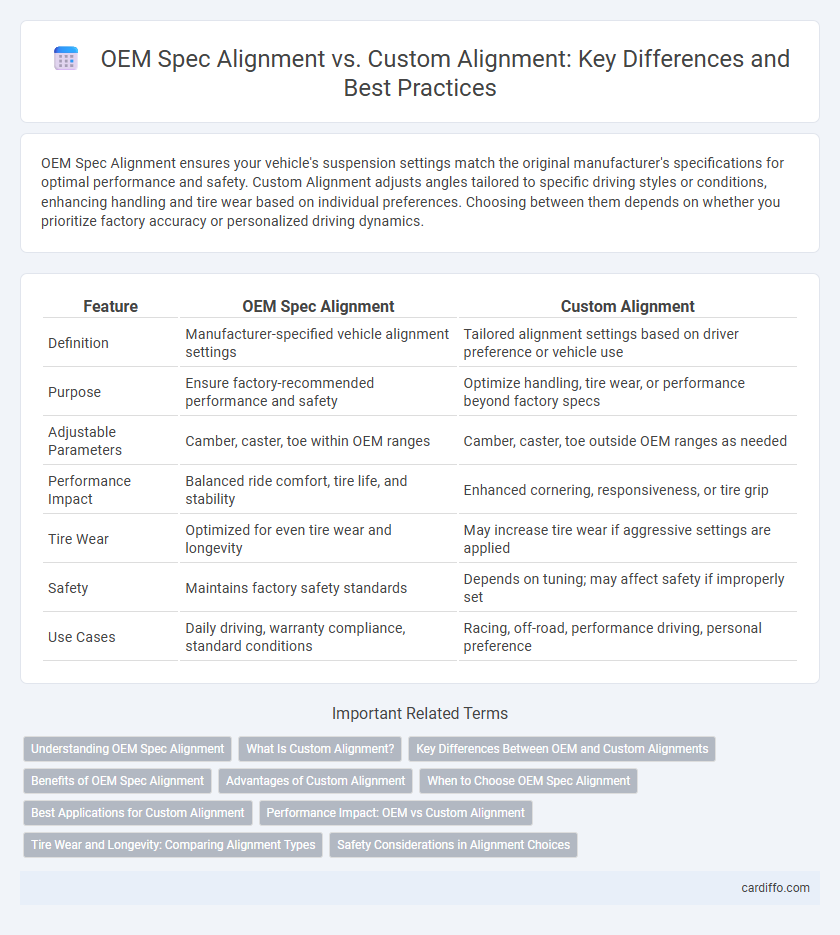OEM Spec Alignment ensures your vehicle's suspension settings match the original manufacturer's specifications for optimal performance and safety. Custom Alignment adjusts angles tailored to specific driving styles or conditions, enhancing handling and tire wear based on individual preferences. Choosing between them depends on whether you prioritize factory accuracy or personalized driving dynamics.
Table of Comparison
| Feature | OEM Spec Alignment | Custom Alignment |
|---|---|---|
| Definition | Manufacturer-specified vehicle alignment settings | Tailored alignment settings based on driver preference or vehicle use |
| Purpose | Ensure factory-recommended performance and safety | Optimize handling, tire wear, or performance beyond factory specs |
| Adjustable Parameters | Camber, caster, toe within OEM ranges | Camber, caster, toe outside OEM ranges as needed |
| Performance Impact | Balanced ride comfort, tire life, and stability | Enhanced cornering, responsiveness, or tire grip |
| Tire Wear | Optimized for even tire wear and longevity | May increase tire wear if aggressive settings are applied |
| Safety | Maintains factory safety standards | Depends on tuning; may affect safety if improperly set |
| Use Cases | Daily driving, warranty compliance, standard conditions | Racing, off-road, performance driving, personal preference |
Understanding OEM Spec Alignment
OEM spec alignment refers to adjusting a vehicle's wheel alignment to the exact specifications provided by the Original Equipment Manufacturer, ensuring optimal handling, tire wear, and safety. This alignment prioritizes maintaining factory settings that balance camber, caster, and toe angles for the specific vehicle model. Understanding OEM spec alignment is crucial for preserving vehicle performance and warranty compliance compared to custom alignment, which tailors settings for individual driving preferences or conditions.
What Is Custom Alignment?
Custom alignment is a precision-driven wheel alignment process tailored to a vehicle's unique specifications beyond standard OEM guidelines. It adjusts camber, caster, and toe angles based on specific driving conditions, performance needs, or aftermarket modifications. This specialized approach enhances handling, tire wear, and overall vehicle stability compared to generic OEM spec alignment settings.
Key Differences Between OEM and Custom Alignments
OEM spec alignment follows manufacturer-defined tolerances ensuring optimal vehicle performance and safety, using standardized measurements specific to each model. Custom alignment offers tailored adjustments beyond OEM limits, catering to unique driving conditions, performance needs, or aftermarket modifications for enhanced handling. Key differences include the precision of factory specs versus the flexibility of customization, impacting tire wear, steering response, and overall driving dynamics.
Benefits of OEM Spec Alignment
OEM spec alignment ensures vehicle suspension and steering components are adjusted to the manufacturer's exact specifications, promoting optimal handling, tire wear, and safety. Maintaining these factory settings supports drivetrain efficiency and preserves warranty compliance, reducing long-term maintenance costs. This alignment type also enhances overall ride comfort by preserving the designed balance and precision of the vehicle's performance.
Advantages of Custom Alignment
Custom alignment offers precise tuning tailored to specific vehicle dynamics and driver preferences, enhancing handling, tire lifespan, and overall safety. Unlike OEM spec alignment, which follows generalized factory settings, custom alignment addresses unique road conditions and individual driving styles for optimal performance. This personalized approach reduces uneven tire wear and improves fuel efficiency by optimizing wheel angles accurately.
When to Choose OEM Spec Alignment
OEM Spec Alignment ensures vehicle performance and safety by adhering to manufacturer-defined tolerances and specifications. Choose OEM Spec Alignment when maintaining factory handling characteristics, optimizing tire wear, and preserving warranty conditions are priorities. This alignment type is ideal for drivers seeking consistency and reliability according to original equipment standards.
Best Applications for Custom Alignment
Custom alignment excels in complex vehicles requiring precise handling adjustments beyond OEM spec ranges, such as high-performance sports cars and off-road vehicles. It optimizes suspension geometry for enhanced tire wear, steering response, and overall stability under specific driving conditions. This tailored approach suits enthusiasts and professionals seeking performance gains or adaptation to modified suspension components.
Performance Impact: OEM vs Custom Alignment
OEM spec alignment ensures vehicles operate within manufacturer-designed tolerances, optimizing tire wear, fuel efficiency, and handling stability under standard driving conditions. Custom alignment adjusts camber, caster, and toe settings beyond OEM specifications, tailored to specific driving styles or performance goals, often enhancing cornering grip and responsiveness at the potential cost of uneven tire wear. Selecting between OEM and custom alignment significantly influences vehicle dynamics, with OEM prioritizing longevity and consistency, while custom alignment maximizes performance and handling precision.
Tire Wear and Longevity: Comparing Alignment Types
OEM spec alignment ensures tire wear consistency and optimizes longevity by maintaining manufacturer-recommended settings tailored for specific vehicle models. Custom alignment adjusts angles based on individual driving habits or road conditions, which can improve handling but may lead to uneven tire wear. Choosing OEM spec alignment prioritizes balanced tire contact and durability, while custom alignment may require frequent monitoring to prevent premature wear.
Safety Considerations in Alignment Choices
OEM spec alignment follows manufacturer guidelines ensuring optimal vehicle handling, stability, and tire wear, which directly enhances safety by maintaining the intended suspension geometry and preventing premature component failure. Custom alignment allows adjustments beyond OEM specs to suit specific driving conditions or performance preferences, but improper settings can compromise traction, increase tire wear, and reduce overall vehicle control. Prioritizing safety in alignment choices requires balancing adherence to OEM specifications with any custom adjustments to avoid alignment angles that could lead to hazardous driving dynamics.
OEM Spec Alignment vs Custom Alignment Infographic

 cardiffo.com
cardiffo.com